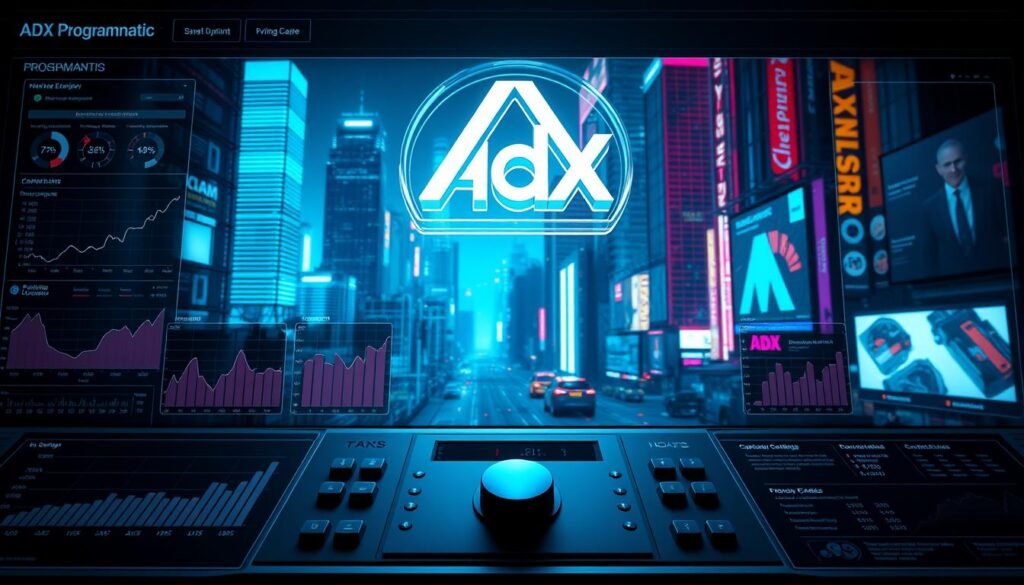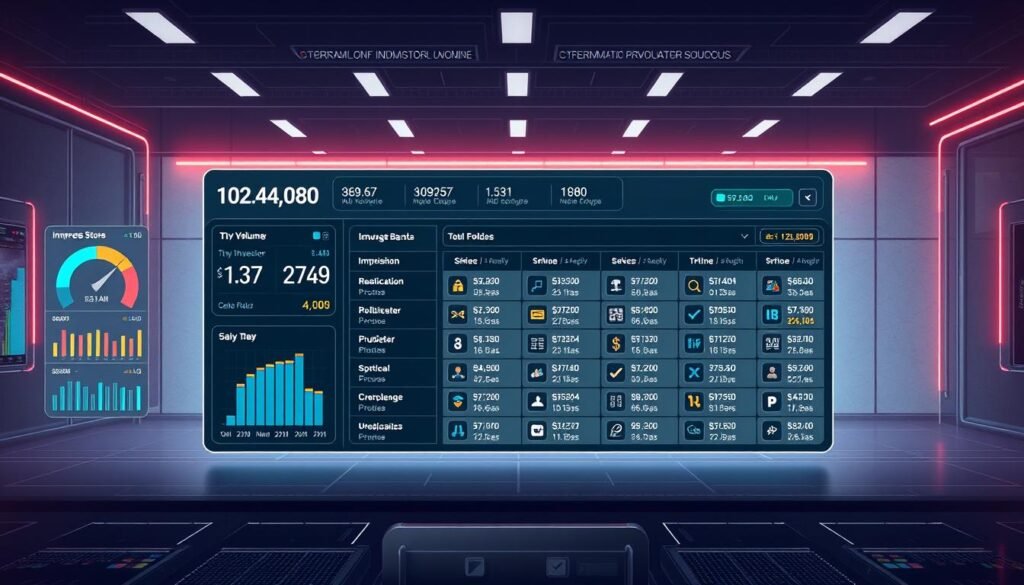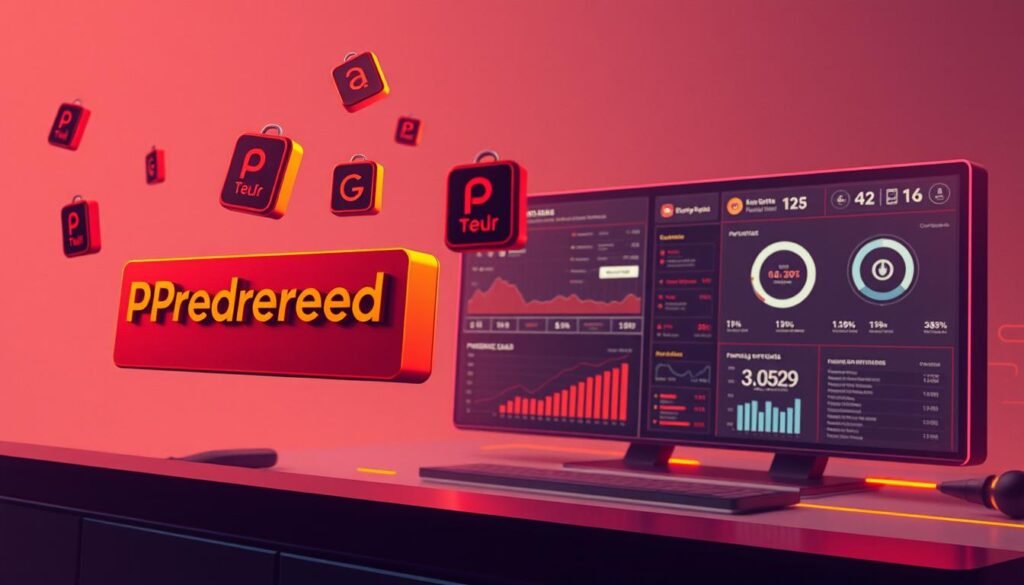Programmatic advertising changed digital media by making buying and selling fast and precise. RTB auctions happen in 30–100 milliseconds. This lets advertisers bid on impressions quickly and publishers get the best prices in real time.
This model grew fast after 2014. Now, AI and machine learning help with targeting, optimizing bids, and testing ads.
Google AdX is key in many programmatic systems. It works with Demand-Side Platforms like DV360 and analytics tools like Google Analytics. AdX offers top-quality inventory for display, video, and CTV ads.
Advertisers use AdX to find valuable spots. Publishers use private auctions and preferred deals to manage prices and relationships with buyers.
This article compares private auctions and preferred deals in AdX programmatic. You’ll learn how they work and their benefits. It also offers tips for advertisers and publishers to choose wisely for growth, safety, and profit.
Key Takeaways
- RTB auctions power real-time automated buying and are central to programmatic advertising.
- AdX Programmatic connects premium publisher inventory with DSPs like DV360 for cross-format reach.
- Private auctions offer competitive bidding among a curated buyer set to boost publisher yield.
- Preferred deals provide negotiated terms and first-look access for advertisers seeking predictability.
- AI-driven optimization and first-party data are increasingly important under privacy rules like CCPA and GDPR.
Overview of Programmatic Advertising and Real-Time Bidding

Programmatic advertising changed how we buy digital ads. It uses data and algorithms to buy ads across different platforms. This way, advertisers can reach more people with targeted ads and quickly adjust their campaigns.
Definition and relationship between programmatic advertising and RTB
Real-time bidding is a key part of programmatic advertising. When a page loads, an auction happens instantly. Buyers bid on that single ad spot. The highest bid wins, thanks to a system that quickly matches buyers with the best ad space.
How RTB transformed ad buying since 2014
Buying ads changed from manual to automated. RTB auctions became more popular, thanks to AI and machine learning. These tools help value ads based on data, making buying smarter.
Investments in ad tech soared, leading to more RTB spending. This change made publishers and brands rethink how they sell and target ads. It allowed for quicker changes and clearer reports, unlike old systems.
Core components: DSPs, SSPs, and ad exchanges
Demand-side platforms like DV360 and The Trade Desk help advertisers set their bids and targets. Supply-side platforms gather publisher ads and show them to buyers.
An ad exchange connects DSPs and SSPs for RTB auctions. This setup makes buying ads fast, clear, and big for everyone involved.
What Is AdX Programmatic
AdX Programmatic is at the heart of programmatic marketplaces. It connects supply-side platforms and demand-side platforms within Google’s ecosystem. This connection helps buyers find top-quality publisher inventory.
The platform offers both open and private pathways. Sellers can control who gets their inventory. Buyers get the chance to target their ads more precisely.

Role of Google AdX in the ad exchange ecosystem
Google AdX is a top ad exchange. It links SSPs, DSPs, and publishers. DV360 customers and other buyers can find great inventory here.
Publishers can segment their inventory. They can choose between open RTB and private marketplaces.
How AdX uses RTB and integrates with DSPs and SSPs
AdX runs RTB auctions in real time. The process starts with the SSP, then moves to the ad exchange. Finally, it reaches DSPs for bidding.
Bids are processed quickly. The winning creative is served in just tens of milliseconds. Major DSPs ensure fast bid responses and consistent auctions.
Why publishers and advertisers use AdX for premium inventory
Publishers use Google AdX to monetize their premium pages and apps. They get to control who buys their inventory and at what price. Advertisers value the curated inventory and Google’s audience signals.
They also appreciate the measurement tools like Active View and Google Analytics. Private marketplaces and preferred deals allow for direct negotiations. This is important for scale or exclusivity.
| Use Case | Benefit on AdX | Typical Channel |
|---|---|---|
| Publisher yield optimization | Floor prices, deal segmentation, and auction transparency | Private RTB, programmatic guaranteed |
| Brand-safe buying | Pre-negotiated deals and first-look access to premium placements | Preferred deals, PMP |
| Cross-channel reach | Access to display, video, YouTube and CTV inventory | Open RTB and curated exchanges |
| Measurement and targeting | Integration with Google measurement tools and audience signals | DSP integrations like DV360 |
Private Auctions Explained
Private auctions, also known as private RTB or PMP, allow publishers to sell their best inventory to a few trusted buyers. This way, high-value spots are only shown to advertisers who are known and valued. It keeps the auction process fair but limits who can bid.

Definition and mechanics of private auctions (PMP/Private RTB)
In private RTB, a publisher’s inventory is shared with a select group of buyers. Only these buyers can bid on the ad space. This process is fast, taking just 30–100 ms, and is designed to keep the auction competitive but controlled.
Use cases for publishers: maximizing yield and controlling supply
Publishers use private auctions to make the most of their best ad spots and leftover inventory. They set minimum prices to ensure they get a fair deal. This is especially true for valuable formats like video and CTV, which are shown to top advertisers.
Advertiser advantages: access to premium inventory and curated buyers
Advertisers get a special chance to reach high-quality ad spaces through private auctions. They can use their own data to target their ads more effectively. This approach helps avoid wasting money and keeps the bidding competitive.
| Aspect | Private Auctions (PMP) | Open RTB |
|---|---|---|
| Buyer access | Invitation-only, vetted DSPs | Any participating DSP |
| Inventory type | Premium publisher inventory, video, CTV | Wider mix, includes lower-value remnant |
| Pricing control | Floor prices and deal rules to protect eCPM | Less control, market-driven clearing price |
| Transparency | Higher transparency on buyers and placements | Lower visibility into buyer pool |
| Use case | Brand-safe buys, premium yield optimization | Scale and broad reach |
Preferred Deals Explained

Preferred deals are special agreements between publishers and advertisers. They agree on a fixed price per thousand impressions (CPM). Advertisers get first access to ad space before it goes to auction. This ensures a stable price and a good chance to get top spots without bidding.
How this differs from auction buys
Auctions work differently. Bids are made in real time, and the highest bidder wins. Preferred deals skip this rush. They give advertisers a chance to buy ad space at a set price before it’s open to others.
Pre-negotiated price and first-look rights
The agreed price makes things predictable. Publishers know how much they’ll make. Advertisers get to see and buy ad space first. But, they only get it if they agree on how much or if they use programmatic guaranteed terms.
When to choose preferred deals
Brand advertisers who want control and safety choose preferred deals. Those with specific audience data find it useful for reaching certain groups on high-quality sites or apps. It’s great for campaigns that value knowing the price and quality of ad placements.
Practical considerations
- Negotiate CPMs to reflect placement quality and expected viewability.
- Use audience signals to enable precise targeted advertising without sacrificing brand safety.
- Confirm reporting and pacing terms so delivery aligns with campaign goals.
Key Differences Between Private Auctions and Preferred Deals
Choosing between private auctions and preferred deals is crucial in programmatic advertising. Each method has its own way of setting prices, controlling access, and managing inventory. These differences help publishers and advertisers decide what’s best for their goals.

Pricing mechanics
Private auctions are competitive, with multiple buyers bidding in real time. The winner is determined by demand and the price set by the publisher. This leads to dynamic pricing and can uncover the value of premium spots.
Preferred deals, on the other hand, involve a fixed price agreed upon beforehand. Advertisers get first dibs at this price, making budgeting easier and reducing price uncertainty.
Control and transparency
In private auctions, publishers have control over who can bid and the minimum prices. They can choose who to allow and block, ensuring ads fit their brand. The auction style also shows how bids change in real time.
Preferred deals give advertisers a clear price and priority access. This makes it easier to plan campaigns with steady costs and known placements. However, the level of transparency can vary based on the platform and agreement.
Guaranteed access, exclusivity, and volume
Private auctions don’t promise a certain number of impressions. The number of impressions depends on the competition and market demand. Publishers can still offer exclusive access to certain buyers within a Private Market Place (PMP).
Preferred deals, however, offer guaranteed access and exclusivity to invited partners. They don’t ensure impressions unless they’re part of a guaranteed program. Brands seeking consistent access to top spots often choose preferred deals for their reliability.
Quick comparison
| Aspect | Private Auction | Preferred Deal |
|---|---|---|
| Pricing model | Dynamic auction mechanics; market-driven | Pre-negotiated price; fixed CPM |
| Buyer control | Publisher controls whitelist and floors | Advertiser obtains first-look and priority access |
| Volume certainty | No guaranteed volume; depends on bids | Priority access; guarantees require programmatic guaranteed |
| Exclusivity | Limited exclusivity via invited bidders | Higher exclusivity among negotiated partners |
AdX Programmatic Inventory Types and Where Deals Fit
The AdX system organizes inventory into different lanes. This helps buyers and sellers find the best fit for value and control. Publishers put premium video and CTV inventory in private channels. Meanwhile, open markets handle leftover traffic.
Clear categories help revenue teams set floor prices and predict earnings. This makes planning easier.

Open RTB and Private RTB
Open RTB is a wide exchange where many DSPs bid in real time. It’s great for big campaigns that want to reach lots of people. Private RTB, on the other hand, only lets invited buyers bid. This keeps competition lower and brand safety higher.
Programmatic Guaranteed and Preferred Deals
Programmatic guaranteed means paying a set price for guaranteed impressions. Advertisers get reserved spots, and publishers get steady income. Preferred deals offer a chance to buy inventory at a negotiated price before auctions start.
How Premium Publishers Surface Inventory
Publishers like The New York Times and CNN put high-value spots into PMPs, preferred deals, or guaranteed contracts. This keeps valuable spots safe from open RTB where quality can vary.
Yield Management: eCPM and Floor Prices
Yield teams set floor prices based on audience, placement, and device. When premium spots go into private deals or guaranteed buys, eCPM usually goes up. This is because buyers pay more for quality. Unsold or lower-value spots then go back to open RTB to avoid waste.
Practical Setup Tips
- Segment inventory by viewability and audience to justify higher floor prices.
- Use preferred deals for targeted brand buys and programmatic guaranteed for campaign certainty.
- Monitor eCPM across channels to decide when to move parcels from open RTB into private lanes.
Targeting and Creative Considerations in Private Auctions

Private auctions offer a precise way to target ads on top-quality sites. Publishers share data that helps platforms make smarter bids. This approach allows for detailed targeting without the risks of open exchanges.
Audience signals and first-party vs third-party data
Advertisers in private RTB use first-party data from publishers for better targeting. Platforms like DV360 can mix this data with third-party segments when allowed. With privacy laws tightening, first-party data is becoming more crucial for safe and effective targeting.
Creative formats and compatibility
Private auctions support various ad types, including display, video, native, and CTV. Each ad type has its own requirements, like VAST for videos and specific templates for native ads. Publishers might limit creative options to keep ads high-quality and user-friendly.
Brand safety and contextual targeting best practices
Advertisers can use whitelists and blacklists with third-party services to lower risks. Contextual signals help avoid inappropriate content when direct user data is scarce. Publishers often add manual blocklists or integrations to ensure brand safety in private deals.
Targeting and Creative Considerations in Preferred Deals
Preferred deals help advertisers and publishers work together better. They make sure everyone knows who they’re targeting and how they’ll measure success. This way, campaigns start off on the right foot with fewer surprises.

How negotiated terms enable precise targeting and data-sharing
Teams can set up clear rules for targeting and data-sharing in preferred deals. This means advertisers can focus on the right people, based on what publishers know. Publishers get to control who sees their ads and how much they pay.
Dynamic creative and DCO opportunities in direct deals
Preferred deals also make it easier to use dynamic creative optimization (DCO). Advertisers can create ads that match the audience they’re targeting. This makes ads more relevant and engaging, while sticking to the agreed-upon standards.
Measuring viewability and placement quality with preferred deals
Measuring success is easier in preferred deals because everyone agrees on what counts. Tools like Active View help check if ads are seen well. This lets advertisers see how their ads stack up against others, helping them improve their campaigns.
Pricing Models, Auction Types, and RTB Nuances
Programmatic pricing is a mix of art and science. Publishers, buyers, and platforms need to understand how different auction types and reserve mechanics work. Having clear rules helps teams plan and manage risks.

First-price auction and second-price auction systems change how bidders act. In a first-price auction, the winner pays exactly what they bid. This makes demand-side platforms use bid shading and machine learning to avoid overpaying.
In a second-price auction, the winner pays a bit more than the second-highest bid. This system used to encourage straightforward bidding. But, the shift to first-price auctions has led to quick updates in DSP algorithms.
Publishers set a floor price or reserve price to protect their inventory’s value. A high floor price can increase expected CPMs. But, it might lead to lower fill rates when demand is low. Setting floors conservatively keeps volume steady, while aggressive floors protect top-tier rates.
Header bidding changes how RTB works. It runs bids across multiple exchanges at once before the main auction. This increases competition and often raises eCPMs because demand is combined, not sequenced.
RTB nuances include latency, bid transparency, and price discovery. Latency can affect who wins. Clear bid landscapes help publishers see true demand. Price discovery evolves as header bidding and exchange auctions interact.
Below is a compact comparison to guide decision-making between common auction and pricing setups.
| Aspect | First-Price Auction | Second-Price Auction |
|---|---|---|
| Payment rule | Winner pays its bid | Winner pays just above second-highest bid |
| Bid strategy | Bid shading and ML to reduce overpayment | Straightforward bidding with less shading |
| Effect on floors | Floor price can more directly lift revenue per win | Floors influence clearing price indirectly |
| Header bidding impact | Aggregates demand; increases winner prices | Raises competition; outcome depends on second-highest bids |
| DSP complexity | Higher; shading and ML required | Lower; simpler bidding logic |
Integration and Workflow: DSP Integration with AdX and Deal Setup
Getting DSP integration right is key for a smooth setup. Advertisers need to align their strategies with the platform steps. This ensures campaigns start without any issues. We’ll use DV360 as an example DSP and explain the importance of IOs, line items, and deal IDs.
https://www.youtube.com/watch?v=DPVz_KGUxaM
Start by setting your campaign goals and KPIs. Determine your budget, target audience, and creative details before you begin. This step helps avoid rework and speeds up the DV360 setup for private auctions or preferred deals.
Campaign build in DV360
First, create an insertion order (IO) to manage your budget and targeting. Then, add line items for different tactics like audience segments or geo-targeting. Each line item is where you attach deal IDs for private inventory.
Attaching deals and technical setup
For private auctions or preferred deals, add the correct deal IDs in the line item settings. Choose the right deal type and upload your creatives. Enable automated bidding to optimize delivery.
IOs, line items and validation
Use pre-launch validation to check your line items and IOs. Make sure they have the right deal IDs and targeting. Save time by using templates for common IOs and line items.
Cross-platform data sync
Integrate first-party segments using partners like LiveRamp or Google’s audience solutions. Map segment IDs between the data provider and DV360. Keep privacy controls and consent flags in check during setup.
Monitoring and automation
After launch, watch your KPIs and adjust settings as needed. Use automated rules in DV360 to handle underdelivery or overspending. Track deal performance to compare different types of deals.
Hand-offs and governance
Document your IOs, line item names, and deal IDs. Share these with data partners for audience updates. Enforce data governance to keep targeting compliant across exchanges.
Performance Measurement and Optimization for Private Auctions
Private auctions need clear metrics and steady optimization to protect revenue and buyer value. Publishers should watch a concise set of KPIs. Advertisers should focus on signals that prove inventory quality.
Key metrics to track
eCPM shows real revenue per thousand impressions. CTR helps spot creative issues or mismatched inventory. Viewability rates, measured with Active View or similar tools, tell you whether ads are seen.
Conversion lift connects impressions to actual outcomes and validates the premium spend. Fill rate and win rate round out the picture for supply health.
Practical optimization tactics
Adjust floor prices by monitoring demand and time-of-day performance to protect eCPM without driving away bids. Segment premium inventory into curated blocks for private auctions. This gives buyers clearer context and better targeting.
Use header bidding to surface competitive bids and increase yield. Apply whitelists and blacklists to control buyer quality and keep viewability high.
A/B testing and buyer-group experiments
Run split tests on inventory slices, such as premium header placements versus open exchange. Measure differences in conversion lift. Test buyer group inclusion in PMPs to see which partners drive the best outcomes by deal ID.
Use automated bidding and machine learning inside DSPs to refine bids in private auctions. This improves cost efficiency.
| Focus | Primary Metric | Optimization Action | Expected Effect |
|---|---|---|---|
| Revenue health | eCPM | Raise or lower floor by segment | Higher average yield per impression |
| Creative fit | CTR | Swap creatives, adjust sizes | Improved engagement and bid interest |
| Visibility | Viewability | Prioritize placements, enforce view standards | Better advertiser satisfaction and retention |
| Performance validation | Conversion lift | Run lift studies and A/B tests | Proof of value for premium inventory |
| Supply health | Fill & win rate | Adjust deal pacing and buyer lists | Balanced volume and price |
Performance Measurement and Optimization for Preferred Deals
Preferred deals need clear goals and steady tracking. Set expectations in insertion orders and track delivery with detailed reports. Use DV360 analytics to check pacing, viewability, and placement quality. Keep teams on the same page with agreed metrics.
Setting measurable KPIs and tracking delivery
Define KPIs in the IO: CPM, viewability, CTR, and conversions. Tie each KPI to a reporting schedule and a delivery threshold. Check daily on impression counts, spend pacing, and placement mix to catch under-delivery early.
Applying automated bidding and machine learning
Use automated bidding in DSPs to focus spend on top-performing preferred deals. Modern algorithms adjust bids based on history and real-time data for better efficiency. Pair automated bidding with budget caps and guardrails to protect prices and avoid overspend.
Addressing attribution and integrating DV360 analytics
Preferred deals make cross-channel attribution tricky. Use DV360 and Google Analytics 360 together to track impressions, clicks, and view-through events. Keep UTM tagging and reporting consistent to avoid data mix-up across systems.
Here’s a quick look at common KPIs, optimization steps, and attribution methods for preferred deals.
| Focus Area | KPI Examples | Optimization Action | Measurement Tool |
|---|---|---|---|
| Delivery & Pacing | Impressions, Spend vs IO, Fill Rate | Adjust pacing rules, reallocate budget across deals | DV360 analytics, Campaign Manager reports |
| Engagement | CTR, Viewability, Time on Site | Shift bids to higher viewability placements, test creatives | DV360 analytics, Google Analytics 360 |
| Performance | Conversions, CPA, ROAS | Enable automated bidding, set conversion goals | DV360 analytics, Floodlight tags |
| Attribution | Last-click, View-through, Incremental lift | Use multi-touch models and third-party lift studies | DV360 analytics + Google Analytics 360 |
| Fraud & Quality | Invalid traffic rate, Brand safety flags | Block low-quality placements, enforce vendor lists | DV360 analytics, third-party verification |
Privacy, Compliance, and Data Governance Impacts
Programmatic deals now face stricter rules and new identifiers. Publishers and advertisers must adjust to meet privacy laws. They need to keep auctions and direct deals working well.
CCPA and GDPR limit third-party data and user identifiers. These rules cut down on cross-site signals in auctions and deals. Browsers and Apple’s IDFA changes make third-party cookies less reliable, pushing teams to rethink targeting.
First-party data is now key for targeting and measuring. Brands and publishers focus on it. They use solutions like LiveRamp and Google’s Authorized Buyers to link signals without exposing raw identifiers. Good first-party data practices boost match rates and value in auctions and deals.
Data governance connects legal, technical, and operational controls. Clear data-processing agreements and consent platforms reduce risks. Campaign teams should check consent, use encrypted identifiers, and share data only as contracts allow.
Monitoring tools help campaigns follow rules and protect revenue. Platforms for marketing data governance and campaign monitoring check targeting, viewability, and spend. Automated alerts for anomalies help catch misconfigurations before they harm yield or attract regulatory attention.
The table below compares key privacy impacts and practical responses for private auctions versus preferred deals.
| Privacy Challenge | Impact on Private Auctions | Impact on Preferred Deals | Recommended Response |
|---|---|---|---|
| CCPA / GDPR restrictions | Limits third-party bidder access and user-level targeting in open auctions | Negotiated data sharing requires explicit DPA and consent checks | Implement DPAs, verify consent strings, and prefer aggregated signals |
| Cookieless environment | Lower match rates for cookies reduce audience precision | Deals can use publisher-owned identifiers or deterministic matches | Invest in first-party identity graphs and deterministic onboarding |
| First-party data reliance | Publishers gain negotiating leverage with high-quality segments | Advertisers secure preferred access using clean-room insights | Scale consented first-party datasets and apply privacy-safe modeling |
| Data governance and auditing | Requires logging of buyer access and lineage for bid requests | Needs contract-level audit trails and delivery reconciliation | Deploy governance platforms, regular audits, and anomaly detection |
| Measurement and attribution | Cross-device and user-level attribution becomes harder | Negotiated reporting can include aggregated lifts and viewability | Use clean-room analytics and aggregated KPIs to preserve privacy |
When to Choose Private Auctions vs Preferred Deals: Strategic Guidance
Publishers and advertisers have to make choices in programmatic sales. This guide helps make those decisions easier. It focuses on picking the right deal for your business goals.
Publisher perspective
Use private auctions (PMPs) for high revenue on rare premium inventory. This method increases eCPMs and keeps control over who buys and at what price.
Go for preferred deals for a steady flow of money. Negotiated CPMs and first-look rights ensure consistent buyers and safe brand placements.
Advertiser perspective
Choose PMPs for finding the best price and moderate reach. They offer targeted audiences and let demand set the value.
Opt for preferred deals for safety and predictability. They offer exclusivity and the chance to share valuable data for top-notch ads and measurable results.
Decision matrix by objective
| Campaign Objective | Best Deal Type | Why it Fits |
|---|---|---|
| Brand awareness / premium placement | Preferred deals or Programmatic Guaranteed | Offers controlled inventory, brand safety, and predictable delivery for high-quality creative. |
| Performance at scale with price discovery | Private auctions (PMPs) | Competitive bidding yields efficient CPMs and broader reach while allowing inventory segmentation. |
| Guaranteed impressions and delivery | Programmatic Guaranteed | Secures volume and timing with contractual commitments and measurement clarity. |
| Mixed goals: scale plus controls | Hybrid approach | Combine PMPs for scale and preferred deals for brand-safe pockets to balance reach and quality. |
When deciding between PMP and preferred deals, start with small tests. Look at viewability, CTR, and conversion rates. Consider inventory segmentation, desired exclusivity, and brand safety before scaling up.
Conclusion
AdX Programmatic is key in today’s advertising world. It supports many types of auctions and deals. Publishers get to keep prices competitive, and advertisers find safe, reliable spots for their ads.
Changes in the industry, like new auction rules and privacy laws, require teams to focus on their own data. They also need to integrate their systems well. Using advanced tools helps protect their earnings and improve how they measure their success.
Choose the right deal type for your goals. Use private auctions to grow your revenue from top publishers. Opt for preferred deals when you need sure spots for your ads. Good DSP integration, clear goals, and using your own data are crucial for success in AdX Programmatic.
